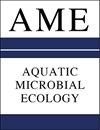法国卢瓦尔河口微底栖植物生物量、多样性和群落结构的时空变化
IF 1.1
4区 环境科学与生态学
Q3 ECOLOGY
引用次数: 3
摘要
研究了法国卢瓦尔河口中盐和多盐河段4个潮间带泥滩以硅藻为主的微底栖植物群落。从生物量、多样性、物种组成和生长形态分布等方面进行了分析。上游2个样地群落生物量高,多样性低,以外缘体为主。下游2个盐碱化样地生物量较低,多样性较高,以表浮游生物和斑浮游生物为主。上游泥滩的多样性没有明显的季节性信号,但在研究的前半段,下游泥滩的多样性较高。两种生长形式的共存似乎增加了泥滩组合的多样性。物种分布主要与沉积物结构和盐度的变化有关,两者都有明显的季节变化。MPB生物量与MPB多样性呈负相关,与泥含量和外皮均呈正相关。然而,MPB多样性与泥浆含量没有显著相关。沉积物质地的轻微变化,即使引起组合组成的变化,也不会改变总体多样性。卢瓦尔河以及其他大型潮汐河口的底栖生物环境中,存在着一个重要的、甚至是占主导地位的食浮游生物部分,这可以被认为是这些底栖生物环境的一个显著特征。本文章由计算机程序翻译,如有差异,请以英文原文为准。
Spatio-temporal variation of microphytobenthos biomass, diversity and assemblage structure in the Loire Estuary, France
: Diatom-dominated microphytobenthos (MPB) communities of 4 intertidal mudflats along the meso- and polyhaline reaches of the Loire Estuary, France, were investigated during a year cycle. They were analysed in terms of biomass, diversity, species composition and growth form distribution. The assemblages of the 2 upstream sites were characterised by high biomass and lower diversities and were mostly dominated by epipelon. The 2 downstream, most haline sites had lower biomass and higher diversities and were dominated by both epipelon and tychoplankton. Diversity did not exhibit a clear seasonal signal in the upstream mudflats, but it was higher during the first half of the study in the downstream sites. The coexistence of 2 growth forms seems to increase diversity of the mudflat assemblages. Species distribution was mainly linked to changes in sediment texture and salinity, both with a marked seasonal variability. MPB biomass was inversely related to MPB diversity and positively related to both mud content and the epipelon. MPB diversity was not, however, significantly correlated with mud content. Slight changes in sediment texture, even if causing variations in assemblage composition, did not change overall diversity. The existence of an important and even dominant tychoplanktonic fraction could be considered a distinctive feature of these benthic environments in the Loire, as well as in other macro tidal estuaries.
求助全文
通过发布文献求助,成功后即可免费获取论文全文。
去求助
来源期刊

Aquatic Microbial Ecology
环境科学-海洋与淡水生物学
CiteScore
3.30
自引率
0.00%
发文量
8
审稿时长
3.0 months
期刊介绍:
AME is international and interdisciplinary. It presents rigorously refereed and carefully selected Research Articles, Reviews and Notes, as well as Comments/Reply Comments (for details see AME 27:209), Opinion Pieces (previously called ''As I See It'') and AME Specials. For details consult the Guidelines for Authors. Papers may be concerned with:
Tolerances and responses of microorganisms to variations in abiotic and biotic components of their environment; microbial life under extreme environmental conditions (climate, temperature, pressure, osmolarity, redox, etc.).
Role of aquatic microorganisms in the production, transformation and decomposition of organic matter; flow patterns of energy and matter as these pass through microorganisms; population dynamics; trophic interrelationships; modelling, both theoretical and via computer simulation, of individual microorganisms and microbial populations; biodiversity.
Absorption and transformation of inorganic material; synthesis and transformation of organic material (autotrophic and heterotrophic); non-genetic and genetic adaptation; behaviour; molecular microbial ecology; symbioses.
 求助内容:
求助内容: 应助结果提醒方式:
应助结果提醒方式:


